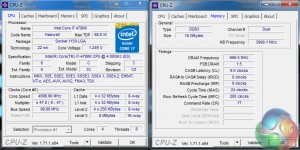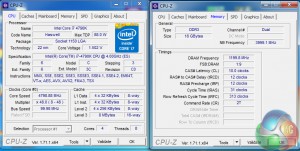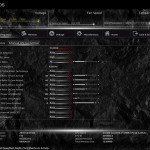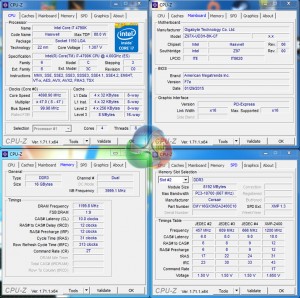Automatic CPU Overclocking – OS-based:
In an attempt to keep this explanation brief, I will start by saying that Gigabyte's pre-defined overclocking profiles are a complete disaster. They're terrible. Putting them on the motherboard is insulting, because less-experienced users who trust the supposed manufacturer know-how will run a serious risk of damaging their CPU.
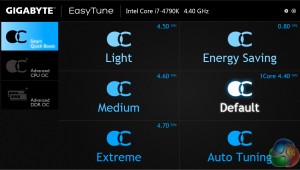
The OS-based overclocking profiles that can be selected via EasyTune range from a 4.5GHz ‘Light‘ option to a 4.7GHz ‘Extreme‘ profile. Both of these profiles see the CPU VCore peaking at 1.452V. Yes, you read correctly – 1.452V! That's about as ‘light' as a truck. A pre-set that forces a liquid-cooled CPU to more than 85°C after seconds of Prime95 is not smart.
Oddly enough, the 4.6GHz ‘Medium‘ profile uses a slightly less extreme CPU VCore of up to 1.38V. Memory speed is dropped to 1333MHz CL9 for all of the profiles.
I cannot comprehend how Gigabyte's well-informed system tuners would ever think that more than 1.45V is sensible for a 22nm processor designed with an 88W TDP in mind. Especially on a £140 mid-range motherboard. Bear in mind that our 4790K, for example, retains complete stability at 4.7GHz with a CPU VCore of around 1.3V.
Fortunately, Gigabyte's OS-based Auto Tuning tool is far more sensible. The process tests a small set of frequency levels to ensure system stability. Auto Tuning registered our CPU as good for a dynamic overclock which turbos up to 4.7GHz (4.5GHz for multi-core activity), with a CPU voltage that peaked around the 1.272V mark. Frustratingly, memory will still be dropped to 1333MHz CL9.
Automatic CPU Overclocking – UEFI-based:
The UEFI-led overclocking pre-sets aren't much better. Very little of the clearly-lacking perception of voltage sensibility seems to have been restored by the UEFI-based profiles. With a 4790K CPU, the ‘Performance Upgrade' profiles are:
- 20% = 4.3GHz static. CPU VCore up to 1.212V. 1600MHz CL11 memory.
- 40% = 4.4GHz static. CPU VCore up to 1.248V. 1600MHz CL11 memory.
- 60% = 4.5GHz static. CPU VCore up to 1.452V. 1866MHz CL11 memory.
- 80% = 4.6GHz static. CPU VCore up to 1.392V. 1866MHz CL11 memory.
- 100% = 4.7GHz static. CPU VCore up to 1.452V. 2133MHz CL11 memory.
Essentially, once you pass the 4790K's maximum turbo level of 4.4GHz (which is automatically applied when XMP is enabled), voltage sensibility disappears. More than 1.452V for an effective 100MHz clock speed increase is ridiculous.
And I have no idea how Gigabyte managed to derive the percentage figures. Since when is adding 300MHz onto a 4000MHz base CPU speed (not to mention wiping a third off the DRAM speed) considered a 20% ‘Performance Upgrade'? Presumably, these have not been updated to present the higher Devil's Canyon speeds.
But the award for most entertaining setting of the day goes to Gigabyte's 4.8GHz ‘CPU Upgrade' profile. 1.524V CPU VCore when loaded. Yes, more than 1.5V on a £140, mid-range, medium-level overclocking motherboard.
Even the 4.6GHz profile was garnished with a CPU VCore level of up to 1.392V.
Manual CPU Overclocking:
To test the Gigabyte Z97X-UD3H-BK motherboard’s CPU overclocking potential, we first increased the CPU VCore to 1.31V, RING (Cache) voltage to 1.275V, CPU VRIN (Input voltage) to 1.900V, and PCH voltage to 1.10V. We also applied the Turbo CPU VRIN load-line calibration (LLC) level and set the cache ratio to 40x.
Our initial overclocking attempts did not provide stability at 4.7GHz, so we were forced to tweak the settings further. Filter PLL was set to ‘High', ‘K OC' mode was applied, System Agent voltage offset was +0.30V, CPU I/O Analogue voltage offset was +0.15V, and CPU I/O Digital voltage offset was +0.20V.
The feature-heavy nature of Gigabyte's UEFI becomes particularly helpful when trying to hold down a stable overclock. Many of the voltage parameters have small pieces of information linked to them in order to explain their function.
4.7GHz was the highest frequency we could reach with our relatively safe voltage levels. Our applied voltage level of 1.31V peaked at 1.332V under full load. A 22mV overshoot is a solid result for a mid-range motherboard.
The overclocking validation can be viewed here.
 KitGuru KitGuru.net – Tech News | Hardware News | Hardware Reviews | IOS | Mobile | Gaming | Graphics Cards
KitGuru KitGuru.net – Tech News | Hardware News | Hardware Reviews | IOS | Mobile | Gaming | Graphics Cards


